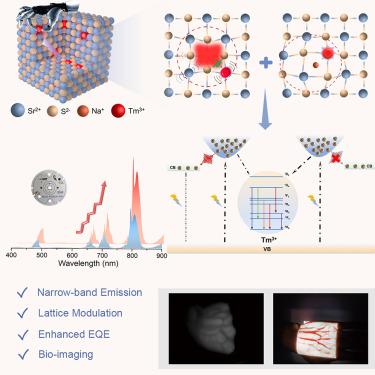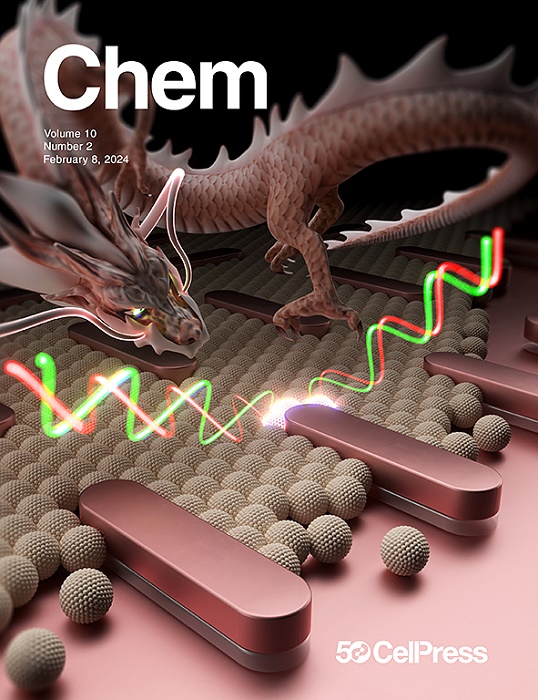通过晶格调制提高铥的窄带近红外发射效率,实现反射吸收生物成像
IF 19.1
1区 化学
Q1 CHEMISTRY, MULTIDISCIPLINARY
引用次数: 0
摘要
基于含氧蛋白质的吸收差异,具有窄带发射的近红外(NIR)发光材料对于大脑和肌肉活动成像至关重要。然而,大多数已知的近红外发光材料都受限于较低的外部量子效率(EQE)和宽带特性。本研究精心设计了掺 Tm、Na 的硫化锶(SrS:Tm3+、Na+)荧光粉,用于近红外发光二极管(LED)。将 Na+ 成功加入 SrS:Tm3+ 中成功掺入 Na+ 有助于抑制晶格声子,从而将 EQE 从 33.6% 显著提高到 53.7%,并增强了热稳定性。固态核磁共振(NMR)、电子顺磁共振(EPR)、瞬态光谱和 X 射线全散射分析表明,晶体学上的 Sr 缺陷和对称晶体的畸变促进了高效的宿主吸收和能量转移。随后,根据血红蛋白的差异吸收有效识别血管模式,使稀土发光材料有望应用于近红外荧光粉转换发光二极管(pc-LED)和生物成像。本文章由计算机程序翻译,如有差异,请以英文原文为准。


Boosting narrow-band near-infrared-emitting efficiency of thulium by lattice modulation for reflective absorption bioimaging
Near-infrared (NIR) luminescence materials with narrow-band emissions are essential for brain and muscle activity imaging based on the absorption difference of oxygenated proteins. However, most known NIR-emitting materials are limited by low external quantum efficiency (EQE) and broadband properties. This work presents the careful design of Tm, Na-doped strontium sulfide (SrS: Tm3+, Na+) phosphor for NIR light-emitting diode (LED), which shows a narrow emitting band of 27 nm. The successful incorporation of Na+ into SrS: Tm3+ contributes to the suppression of lattice phonons, resulting in significant improvement in EQE from 33.6% to 53.7% and an increase in thermal stability. The efficient host absorption and energy transfer are facilitated by the crystallographic Sr defects and the distortion in the symmetric crystal, disclosed by solid-state NMR, electron paramagnetic resonance (EPR), transient spectra, and X-ray total scattering analysis. Subsequently, efficient identification of vascular patterns based on the differential absorption of hemoglobin enables the potential application of rare-earth luminescent materials in NIR phosphor-converted light-emitting diodes (pc-LEDs) and bioimaging.
求助全文
通过发布文献求助,成功后即可免费获取论文全文。
去求助
来源期刊

Chem
Environmental Science-Environmental Chemistry
CiteScore
32.40
自引率
1.30%
发文量
281
期刊介绍:
Chem, affiliated with Cell as its sister journal, serves as a platform for groundbreaking research and illustrates how fundamental inquiries in chemistry and its related fields can contribute to addressing future global challenges. It was established in 2016, and is currently edited by Robert Eagling.
 求助内容:
求助内容: 应助结果提醒方式:
应助结果提醒方式:


